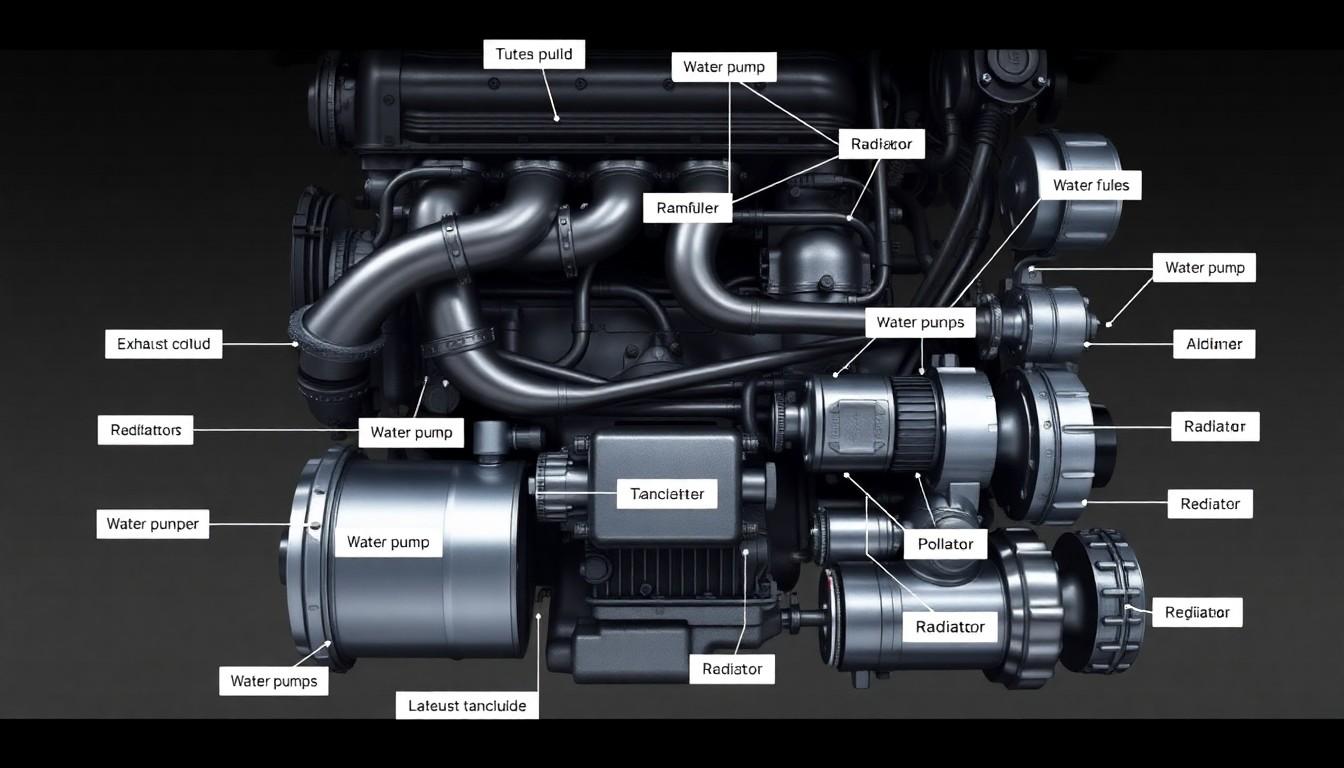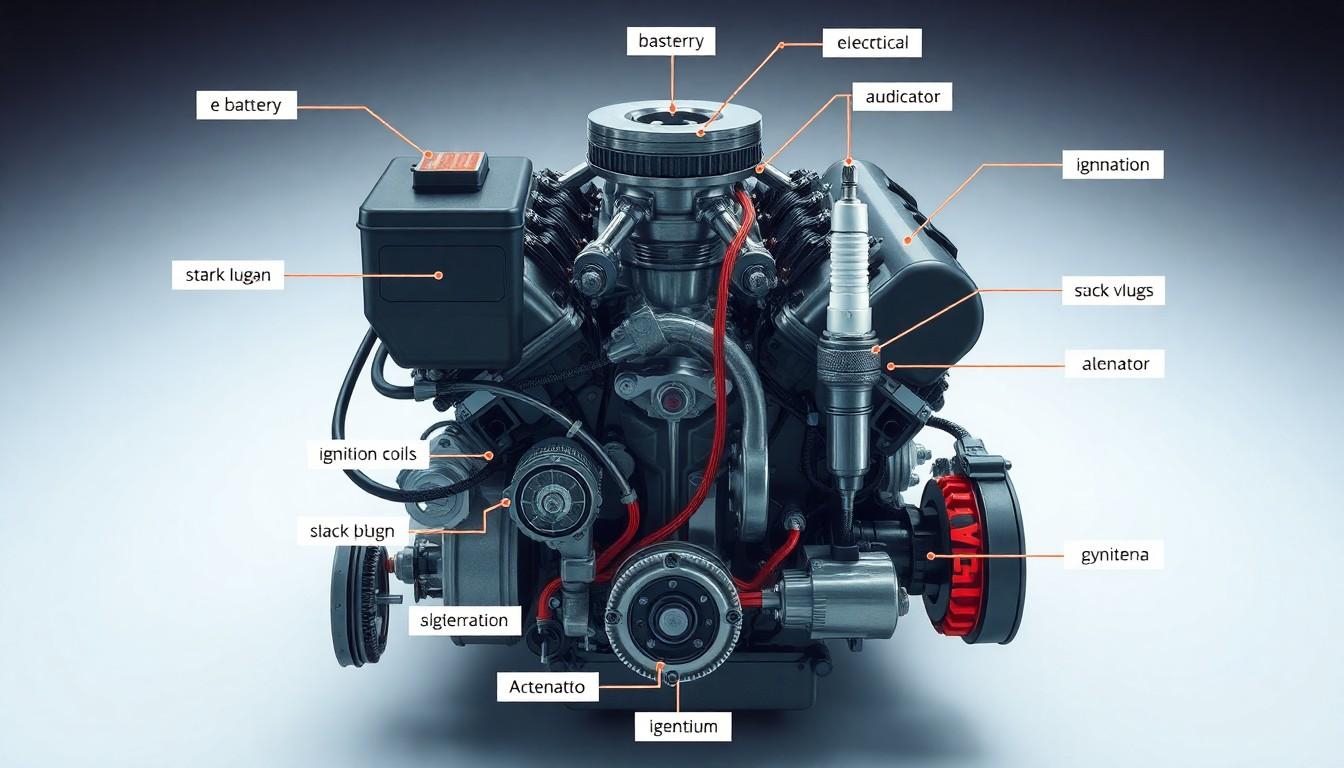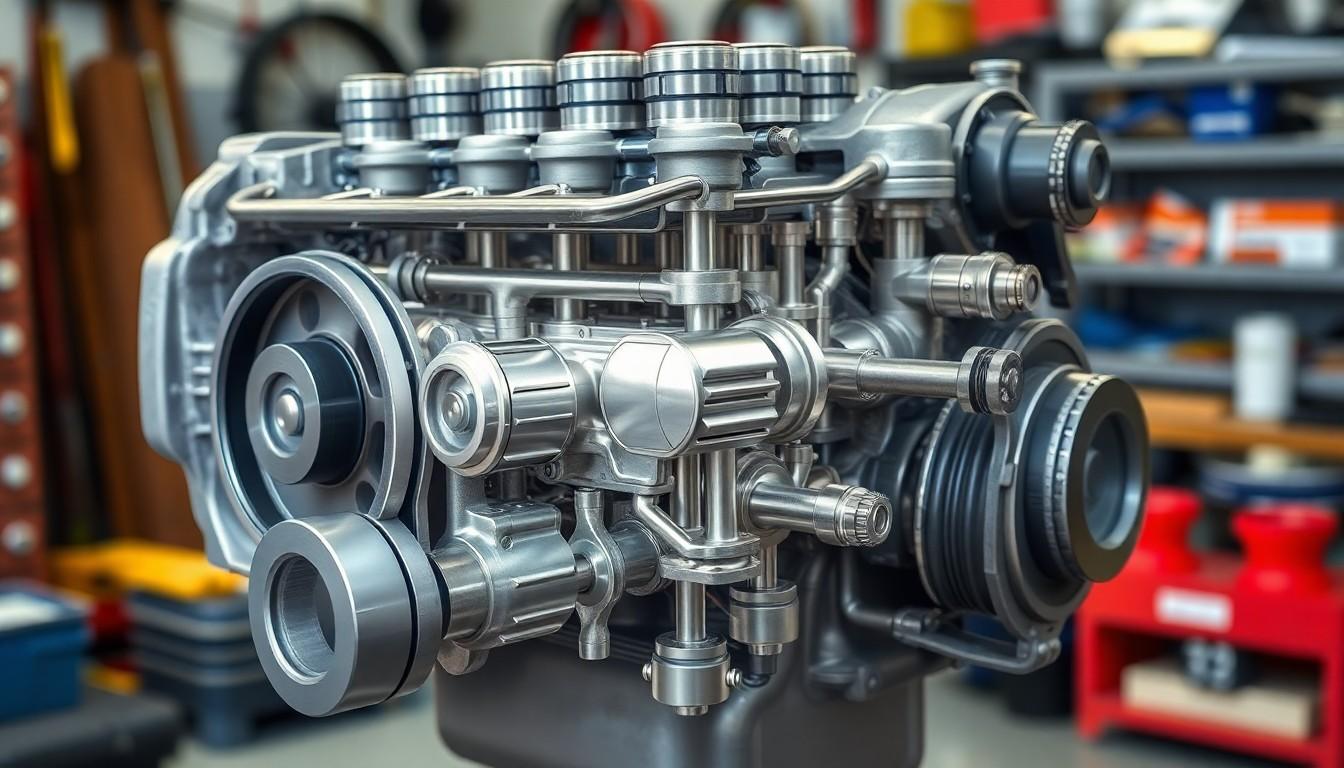Ever wondered what makes your car roar to life when you turn the key? Understanding the parts of an engine diagram is essential for anyone looking to master basic vehicle maintenance or troubleshoot problems without costly mechanic visits.
We’ve created this comprehensive guide to demystify the complex industry of engine components. From the combustion chamber to the cooling system, we’ll break down each vital part in simple terms anyone can understand. Whether you’re a curious car owner or an aspiring mechanic, knowing how these components work together will empower you to make informed decisions about your vehicle’s care.
Understanding the Basics of an Engine Diagram
Engine diagrams serve as visual roadmaps for understanding the complex mechanical systems that power vehicles. These technical illustrations break down the intricate components of an engine into clear, identifiable parts that show their relationships and functions. Reading engine diagrams requires basic familiarity with standard symbols and component representations commonly used across automotive documentation.
Most engine diagrams use a combination of labeled illustrations, color coding, and cross-sectional views to represent different systems. Each component typically includes identification numbers or codes that correspond to parts catalogs and repair manuals. Manufacturers create these diagrams with consistent conventions that allow mechanics and vehicle owners to navigate the engine’s structure effectively.
The ability to interpret these diagrams provides many practical benefits for vehicle maintenance. Correctly identifying parts helps in troubleshooting issues, ordering the right replacement components, and understanding how systems interact. Even a basic comprehension of engine diagrams empowers car owners to communicate more effectively with mechanics and make informed decisions about repairs.
Learning to read engine diagrams doesn’t require extensive mechanical knowledge. The key lies in understanding the core components and their relationships before moving to more specialized parts. This foundation creates a framework for deeper mechanical comprehension and practical application during maintenance tasks.
Major Engine Components in a Typical Diagram

Engine diagrams showcase the various interconnected parts that work together to power a vehicle. These visual representations highlight key components organized in exact sections that help mechanics and car enthusiasts understand how engines function.
Engine Block and Cylinder Head
The engine block serves as the foundation of any engine, typically constructed from cast iron or aluminum materials. It houses multiple critical components including cylinders, the crankshaft, pistons, and connecting rods. Within this core structure, you’ll find carefully designed pathways that allow coolant and oil to circulate throughout the engine, maintaining optimal operating temperatures and providing essential lubrication.
The cylinder head attaches to the top of the engine block using multiple bolts and a head gasket that creates a tight seal between these two major components. This crucial part contains several elements that control airflow and exhaust, including valve springs, valves, lifters, pushrods, rockers, and sometimes camshafts. These components work together to regulate the intake of air and the release of exhaust gases during the combustion process.
Crankshaft and Pistons
The crankshaft occupies the bottom section of the engine block and performs the essential function of converting vertical piston movement into rotational motion. Connected to pistons via connecting rods, this precisely machined and balanced component ensures smooth engine operation throughout varying RPM ranges. Its design allows it to transfer power from the combustion process to the transmission system.
Pistons feature a cylindrical design with flat tops that move up and down within the engine cylinders. These components transfer the energy generated during combustion directly to the crankshaft through connecting rods. Each piston comes equipped with specialized piston rings on its lower portion that serve two primary purposes: increasing compression within the cylinder and reducing friction between the piston and cylinder wall.
Valvetrain Components
Valves control the flow of air-fuel mixture into the combustion chamber and allow exhaust gases to exit after combustion. Located in the cylinder head, these components come in two varieties: intake valves that open to admit the air-fuel mixture and exhaust valves that release spent gases after combustion completes.
The camshaft operates in synchronization with the crankshaft via a timing chain or belt. This precision-engineered component pushes valves open and closed at exactly the right moments in the combustion cycle, ensuring optimal engine performance. In overhead valve engines, lifters and pushrods transmit motion from the camshaft to the valves, with lifters available in either hydraulic or solid designs.
Rocker arms pivot on a shaft and act as mechanical levers that transfer motion from the pushrods to the valves. These components multiply the force applied by the camshaft, providing the necessary pressure to open valves against spring tension during engine operation.
Fuel and Air Intake System Parts

The fuel and air intake system delivers the perfect mixture of fuel and air to the engine’s combustion chambers, directly impacting performance and efficiency. These components work together to ensure your engine receives clean air and precisely measured fuel for optimal combustion.
Carburetor vs. Fuel Injection Systems
Carburetors represent the older technology for mixing air and fuel, operating on vacuum principles to draw fuel into the airstream. They contain several key components: a venturi that increases air velocity to create low pressure, a float bowl for storing fuel, and jets that regulate fuel flow into the venturi. Even though their simplicity, carburetors typically offer less precise fuel metering compared to modern alternatives.
Fuel injection systems provide a more efficient and electronically controlled method of delivering fuel to the engine. These systems use fuel injectors to spray precisely measured amounts of fuel either into the intake manifold or directly into cylinders. An electric fuel pump supplies constant pressure to the injectors, while the Engine Control Unit (ECU) calculates the exact timing and quantity of fuel needed based on various sensor inputs. Fuel injection delivers better fuel economy, improved engine performance, and lower emissions than carbureted systems.
Air Filters and Intake Manifolds
Air filters serve as the first line of defense for your engine, trapping dust, pollen, and various airborne contaminants before they can enter and potentially damage internal components. Clean air filters maintain proper airflow and prevent premature engine wear, making them critical for both performance and longevity. Most vehicles use paper, cotton, or foam filter elements that require replacement at regular intervals.
Intake manifolds distribute the air-fuel mixture evenly to each cylinder through dedicated intake ports. In carbureted engines, the manifold receives the pre-mixed air-fuel combination, while in fuel-injected vehicles, it primarily directs airflow with fuel being added separately. The throttle body, connected to the accelerator pedal, controls the amount of air entering the engine by opening and closing a valve. Modern intake manifolds often feature variable geometry designs that optimize airflow at different engine speeds, improving both low-end torque and high-end power.
Exhaust and Cooling System Elements

The exhaust and cooling systems work in tandem with the engine to maintain optimal performance and temperature regulation. These critical components manage heat dissipation and exhaust gas removal, ensuring the engine operates efficiently under various conditions.
Exhaust Manifolds and Mufflers
Exhaust manifolds connect directly to the cylinder head, collecting exhaust gases from multiple cylinders and funneling them into a single pipe. They’re typically constructed from cast iron or stainless steel to withstand extreme temperatures generated during combustion. Exhaust manifolds serve as the starting point of the exhaust system, creating a pathway for harmful emissions to exit the engine.
Mufflers reduce the noise level produced by escaping exhaust gases through a series of chambers and baffles. Located further down the exhaust line, these components contain perforated tubes and sound-absorbing materials that dampen sound waves. Engine diagrams often show mufflers positioned under the vehicle, connected to the exhaust manifolds via pipes that run along the undercarriage.
Radiator and Water Pump Components
Radiators sit at the front of the vehicle and function as heat exchangers that cool the hot coolant circulating through the engine. They consist of a network of tubes and fins that maximize surface area for efficient heat dissipation. Cool air passes through the radiator as the vehicle moves (or with help from electric fans), reducing the coolant temperature before it returns to the engine.
Water pumps circulate coolant throughout the engine block and cylinder head, ensuring consistent temperature regulation. These pumps are typically driven by the serpentine belt or timing belt and create pressure that moves coolant through the entire cooling system. Modern engine diagrams show water pumps mounted on either the engine block or cylinder head, connected to the radiator via rubber hoses that complete the cooling circuit.
Additional cooling system elements include the thermostat, which regulates coolant flow based on engine temperature, and various hoses and belts that connect components together. The thermostat remains closed when the engine is cold to help it reach operating temperature faster, then opens gradually as the engine warms up to allow coolant circulation through the radiator.
Electrical and Ignition Parts on Engine Diagrams

Electrical and ignition components form a crucial network that powers and controls the combustion process in modern vehicles. These parts work in harmony to generate, distribute, and manage the electrical current necessary for engine operation.
Battery and Alternator
The battery serves as the primary power source for starting the engine, though it’s typically located in the engine compartment rather than directly attached to the engine itself. Engine diagrams often show the battery positioned at the front or side of the compartment, connected to various electrical systems through positive and negative terminals. The alternator, attached to the engine and driven by the serpentine belt, generates electrical power to recharge the battery and supply electricity to the vehicle’s systems during operation. Most engine diagrams identify the alternator by its distinctive fan-like appearance, usually mounted on the side of the engine block with visible pulley connections to the drive belt system.
Spark Plugs and Ignition Coils
Spark plugs appear in engine diagrams as small components screwed into the cylinder head, positioned to extend into each combustion chamber. These critical ignition elements create the spark that ignites the air-fuel mixture in gasoline engines. Ignition coils, responsible for generating the high voltage needed for spark plug operation, are depicted differently depending on the engine design. Modern engine diagrams often show individual coil-on-plug arrangements directly mounted above each spark plug, eliminating the need for spark plug wires. Older engine designs might feature a centralized coil connected to a distributor system that directs voltage to each spark plug in the firing sequence. The ignition module, frequently integrated into the engine control unit (ECU) in contemporary vehicles, manages the precise timing of each spark to optimize combustion efficiency and engine performance.
How to Read and Interpret Engine Diagrams

Main Components
Engine diagrams center around the engine block, which houses the pistons, crankshaft, and connecting rods. The cylinder head sits atop the block as a detachable upper section supporting the camshaft and valves. Inside the cylinders, pistons move up and down, powered by combustion forces. A crankshaft converts this vertical motion into rotational energy that powers your vehicle. Camshafts operate both intake and exhaust valves, ensuring they open and close at precisely the right moments during engine operation.
Additional Key Parts
Timing chains or belts synchronize the rotation between crankshaft and camshaft components for proper valve timing. Connecting rods link the pistons directly to the crankshaft, transferring power through the system. Spark plugs serve as ignition sources for the air-fuel mixture within combustion chambers. The oil pan collects and stores engine oil essential for lubricating moving parts. Flywheels attach to the crankshaft’s end, smoothing out power delivery and connecting to the transmission system. Head gaskets create critical seals between the cylinder head and engine block to prevent leaks.
Reading the Diagram
Starting with major sections helps orient yourself when examining engine diagrams – look for clearly labeled engine block and cylinder head components. Moving parts like pistons, connecting rods, and the crankshaft typically appear within the engine block area. Valve operation illustrations often include arrows showing airflow directions and cam movements. Timing system components connect the crankshaft and camshaft, maintaining their synchronized movement. Accessory components such as the oil pan, flywheel, and spark plugs generally appear around the main block and head perimeter.
Interpreting Functions
The combustion process begins when spark plugs ignite the air-fuel mixture, forcing pistons downward and rotating the crankshaft. Mechanical linkages throughout the engine connect various components – rods link pistons to the crankshaft while the camshaft operates valves through lifters and rocker arms. Lubrication systems distribute oil from the pan throughout the engine, reducing friction between moving parts. Cooling system components regulate temperature, preventing overheating during operation. Understanding these functional relationships helps decode how each part contributes to the engine’s overall performance.
Conclusion
Understanding the parts of an engine diagram equips you with valuable knowledge for vehicle maintenance and repair. We’ve explored everything from the engine block to electrical systems showing how these components work together in harmony.
Armed with this knowledge you’ll communicate more effectively with mechanics save money on repairs and make informed decisions about your vehicle. Remember that engine diagrams aren’t just technical references they’re practical tools that demystify what happens under your hood.
The next time you pop the hood you’ll see beyond a complex array of parts and recognize the sophisticated system that powers your car. This understanding is invaluable whether you’re a DIY enthusiast or simply want to be a more informed vehicle owner.
Frequently Asked Questions
What is the main purpose of an engine block?
The engine block serves as the foundation of the engine, housing critical components like cylinders, crankshaft, and pistons. Made from cast iron or aluminum, it provides structural integrity and contains the combustion process. The block also includes water jackets that help in cooling the engine by circulating coolant around the cylinders.
How do pistons and crankshafts work together?
Pistons capture energy from combustion and move vertically within cylinders. The crankshaft converts this vertical motion into rotational force through connecting rods attached to the pistons. This rotation ultimately powers your vehicle’s wheels. This relationship is fundamental to how internal combustion engines generate usable power.
What’s the difference between carburetors and fuel injection systems?
Carburetors use vacuum principles to mix fuel and air but offer less precision. Fuel injection systems deliver fuel directly into the intake manifold or combustion chamber with electronic control, providing better efficiency, improved power, and reduced emissions. Modern vehicles predominantly use fuel injection due to these advantages and stricter emission standards.
Why are engine diagrams important for vehicle owners?
Engine diagrams help decode complex mechanical systems by breaking down components into identifiable parts and illustrating their relationships. They aid in troubleshooting issues, ordering correct replacement parts, and communicating effectively with mechanics. Even with basic mechanical knowledge, understanding these diagrams provides a solid foundation for vehicle maintenance and repair.
What components make up the valvetrain system?
The valvetrain consists of valves, camshaft, lifters, pushrods, and rocker arms. This system regulates the intake of air-fuel mixture and release of exhaust gases. The camshaft controls valve timing, while lifters, pushrods, and rocker arms transfer this motion to the valves. Proper functioning ensures optimal engine performance and efficiency.
How does the cooling system prevent engine overheating?
The cooling system circulates coolant through the engine to absorb heat and transfers it to the radiator, where it dissipates into the air. The water pump ensures continuous coolant flow, while the thermostat regulates temperature by controlling coolant circulation. This system is crucial for preventing overheating that could cause serious engine damage.
What role do spark plugs play in engine operation?
Spark plugs create electric sparks that ignite the air-fuel mixture in combustion chambers, initiating the power stroke. They must deliver the right amount of spark at precisely the right moment for efficient combustion. Well-functioning spark plugs ensure proper engine performance, fuel efficiency, and lower emissions.
How do I interpret electrical components in engine diagrams?
Look for the battery (power source), alternator (recharges the battery), ignition coils (generate high voltage), and spark plugs (ignite fuel mixture). Modern diagrams also show sensors and electronic control units. Understanding these connections helps diagnose electrical issues and ensures proper maintenance of these critical engine systems.

